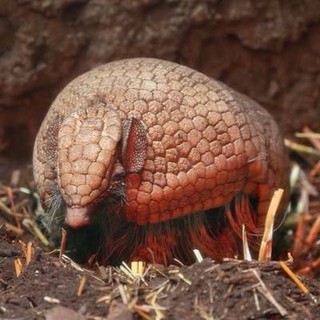- The introduction of Bugsy, the Southern three-banded armadillo, to his new home and community on the Tropics Trail.
- The role of the Association of Zoos & Aquariums (AZA) in the mass relocation of animals, highlighting the collective effort in wildlife conservation.
- The significance of Bugsy’s diet and behavior in understanding Southern three-banded armadillos.
- Overview of zoo management and the occupational care involved in rehoming and maintaining animal welfare.
- Encouraging public involvement and education through visits and newsletter subscriptions.
The Southern three-banded armadillo is a small, armor-clad mammal with a charming personality. These armadillos are known for their distinctive ability to roll into a tight ball, a unique defense mechanism among armadillos, thanks to their three, flexible, armored bands. Bugsy, a 10-month-old Southern three-banded armadillo, has recently found a new home on the Tropics Trail. After the closure of a local Twin Cities aquarium, Bugsy, amongst other animals, was relocated thanks to the coordinated effort of the Association of Zoos & Aquariums (AZA). This effort highlights the dedication to wildlife conservation and animal welfare. The AZA takes pride in these endeavors, providing safe refuges and new beginnings for animals in times of need. By joining the community of golden lion tamarins, Bugsy adds a unique presence to the existing ecological tapestry.
Bugsy’s introduction exemplifies the challenges and successes in zoo management, especially in regard to animal relocations. More than 1,400 animals were successfully rehoused across various facilities, a testament to the collaborative spirit and logistical expertise of the AZA network. Such massive undertakings require precise planning, expert care, and exceptional veterinary oversight. Over 100 animals found refuge with us, and each one received thoughtful care from our dedicated team. Our expert animal care staff ensures every creature receives the attention needed to adapt and thrive in their new surroundings.
Armadillos, as armored mammals, possess intriguing dietary habits and behavioral traits that serve significant roles in their survival. Characteristically, Southern three-banded armadillos subsist on a diet mainly composed of insects, complemented by fruits and vegetables. Bugsy shares a dynamic relationship with his golden lion tamarin neighbors, Frank and Callisto, benefiting from the fruits and treats that drop from above. Such interactions provide invaluable enrichment as they mimic the diverse and interactive ecosystem these creatures would encounter in the wild.
An essential component of any wildlife conservation effort is understanding the animals’ natural behaviors and dietary needs. Armadillos play a crucial ecological role by controlling insect populations. Their foraging behavior, involving digging and probing with their snouts, shapes the environment by aerating soil and cycling nutrients. Visitors to the Tropics Trail have the opportunity to witness Bugsy engaging in these activities, experiencing firsthand the role such creatures play in their habitats.
Zoo management extends far beyond the mere exhibition of animals. It involves a commitment to ecological stewardship and public education. Providing for creatures like Bugsy involves understanding each animal’s specific needs, replicating natural habitats, and offering species-appropriate enrichments. This approach ensures animals thrive and exhibit natural behaviors, contributing to conservation efforts and educating the public. Moreover, the association between multiple species, as seen with Bugsy and the tamarins, showcases the interconnectedness inherent in biological communities.
As stewards of wildlife, we understand the importance of public engagement and education. Visits to observe Bugsy and his companions on the Tropics Trail foster an appreciation for biodiversity and the complexities of ecosystem interrelationships. Educational efforts are amplified through engaging exhibits, informative narrations, and opportunities for visitors to directly observe and connect with the animals.
A vibrant, informed public can significantly contribute to conservation efforts. Encouraging engagement through newsletters and on-site interactions broadens the reach of our educational initiatives and bolsters attachment to conservation causes. By welcoming visitors to follow updates on Bugsy and other inhabitants, we promote a culture of awareness, advocacy, and action. Such involvement fosters a community dedicated to the welfare and conservation of wildlife, a critical factor in sustaining ecological diversity.
Bugsy’s relocation and subsequent integration into the Tropics Trail serves as a beacon of successful animal care, conservation, and community engagement. As we continue to refine our approaches to zoo management, our commitment to animal welfare and public involvement remains steadfast. Through educational outreach and a focus on the natural lives of creatures like Bugsy, we aim to inspire a deeper understanding of and connection to the world’s diverse wildlife.
*****
Source Description
We’re excited to introduce you to Bugsy, the 10-month-old Southern three-banded armadillo! He’s settled in with the golden lion tamarins on the Tropics Trail after moving from a Twin Cities aquarium that closed this past February. Thanks to the help of the Association of Zoos & Aquariums (AZA), more than 1,400 animals were rehomed across multiple zoos, aquariums, and rescue organizations. We’re honored to provide a home to Bugsy and more than 100 other animals during their time of need. Our team of expert animal care and health staff provided each animal TLC and individual attention as they start their new lives with us. As his name suggests, Bugsy loves snacking on bugs, fruits, and veggies—especially treats that fall from his tamarin friends above, Frank and Callisto! He also enjoys digging around in natural bedding like soil and logs. Come see Bugsy having a ball in his new home! For more Zoo updates, like new animals and insider updates, join our newsletter email list at the link in our bio.


